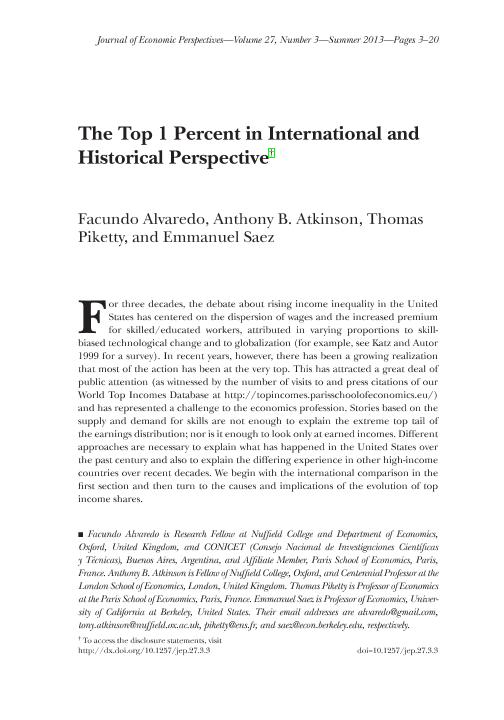Mostrar el registro sencillo del ítem
dc.contributor.author
Gonzalez Alvaredo, Facundo

dc.contributor.author
Atkinson Abutridy, John Anthony

dc.contributor.author
Piketty, Thomas
dc.contributor.author
Saez, Emmanuel
dc.date.available
2017-11-02T19:45:19Z
dc.date.issued
2013-07
dc.identifier.citation
Gonzalez Alvaredo, Facundo; Atkinson Abutridy, John Anthony; Piketty, Thomas; Saez, Emmanuel; The Top 1 Percent in International and Historical Perspective; American Economic Association; Journal of Economic Perspectives; 27; 3; 7-2013; 3-20
dc.identifier.issn
0895-3309
dc.identifier.uri
http://hdl.handle.net/11336/27462
dc.description.abstract
The top 1 percent income share has more than doubled in the United States over the last 30 years, drawing much public attention in recent years. While other English-speaking countries have also experienced sharp increases in the top 1 percent income share, many high-income countries such as Japan, France, or Germany have seen much less increase in top income shares. Hence, the explanation cannot rely solely on forces common to advanced countries, such as the impact of new technologies and globalization on the supply and demand for skills. Moreover, the explanations have to accommodate the falls in top income shares earlier in the twentieth century experienced in virtually all high-income countries. We highlight four main factors. The first is the impact of tax policy, which has varied over time and differs across countries. Top tax rates have moved in the opposite direction from top income shares. The effects of top rate cuts can operate in conjunction with other mechanisms. The second factor is a richer view of the labor market, where we contrast the standard supply-side model with one where pay is determined by bargaining and the reactions to top rate cuts may lead simply to a redistribution of surplus. Indeed, top rate cuts may lead managerial energies to be diverted to increasing their remuneration at the expense of enterprise growth and employment. The third factor is capital income. Overall, private wealth (relative to income) has followed a U-shaped path over time, particularly in Europe, where inherited wealth is, in Europe if not in the United States, making a return. The fourth, little investigated, element is the correlation between earned income and capital income, which has substantially increased in recent decades in the United States.
dc.format
application/pdf
dc.language.iso
eng
dc.publisher
American Economic Association
dc.rights
info:eu-repo/semantics/openAccess
dc.rights.uri
https://creativecommons.org/licenses/by-nc-sa/2.5/ar/
dc.subject
Altos Ingresos
dc.subject
Impuestos
dc.subject
Riqueza
dc.subject
Herencia
dc.subject.classification
Otras Economía y Negocios

dc.subject.classification
Economía y Negocios

dc.subject.classification
CIENCIAS SOCIALES

dc.title
The Top 1 Percent in International and Historical Perspective
dc.type
info:eu-repo/semantics/article
dc.type
info:ar-repo/semantics/artículo
dc.type
info:eu-repo/semantics/publishedVersion
dc.date.updated
2017-11-01T16:52:33Z
dc.journal.volume
27
dc.journal.number
3
dc.journal.pagination
3-20
dc.journal.pais
Estados Unidos

dc.journal.ciudad
Pittsburgh
dc.description.fil
Fil: Gonzalez Alvaredo, Facundo. Consejo Nacional de Investigaciones Científicas y Técnicas; Argentina. University of Oxford; Reino Unido
dc.description.fil
Fil: Atkinson Abutridy, John Anthony. The London School of Economics and Political Sc.; Reino Unido
dc.description.fil
Fil: Piketty, Thomas. Paris School of Economics; Francia
dc.description.fil
Fil: Saez, Emmanuel. University of California at Berkeley; Estados Unidos
dc.journal.title
Journal of Economic Perspectives
dc.relation.alternativeid
info:eu-repo/semantics/altIdentifier/url/https://www.aeaweb.org/articles?id=10.1257/jep.27.3.3
dc.relation.alternativeid
info:eu-repo/semantics/altIdentifier/doi/http://dx.doi.org/10.1257/jep.27.3.3
Archivos asociados
